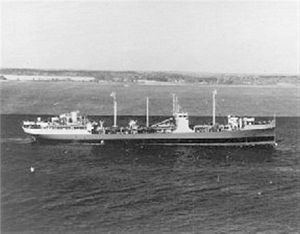Name USS Maumee (AO-2) Laid down 23 July 1914 Decommissioned 5 November 1946 Launched 17 April 1915 Weight 6.577 tons | Commissioned 20 October 1916 Construction started 23 July 1914 Length 145 m | |
 | ||
Builder | ||
Launching of uss maumee ao 2 from mare island naval shipyard in vallejo califor hd stock footage
The second USS Maumee (AO-2) was laid down as Fuel Ship No. 14 on 23 July 1914 by Navy Shipyard, Mare Island, Calif.; launched 17 April 1915; sponsored by Miss Janet Crose; and commissioned 20 October 1916, Lt. Comdr. Henry C. Dinger in command. When the Navy’s ship classifications were introduced 17 July 1920, Maumee was designated AO-2.
Contents
- Launching of uss maumee ao 2 from mare island naval shipyard in vallejo califor hd stock footage
- Early career
- World War II
- Postwar Service
- References
Maumee was the first surface ship in the U.S. Navy to be powered by diesel engines. Supervising their installation and operation was her Executive and Chief Engineering Officer, Lt. Chester W. Nimitz. To be fitted with the engines after it was built, the ship was towed all the way from Union Iron Works in San Francisco to the Brooklyn Navy Yard. As of January, 1919 she had two 3,600 h.p. diesel engines running at 125 rpm.
Early career
Prior to the entry of the United States into World War I, Maumee operated off the east coast and Cuba. Following the declaration of war, 6 April 1917, she was assigned duty refueling at sea the destroyers being sent to Britain. Stationed about 300 miles south of Greenland, Maumee was ready for the second group of U.S. ships to be sent as they closed her 28 May. With the fueling of those six destroyers, Maumee pioneered the Navy’s underway refueling operations, thus establishing a pattern of mobile logistic support which would enable the Navy to keep its fleets at sea for extended periods, with a far greater range independent of the availability of a friendly port. This independence proved crucial to victory in World War II by the ships commanded by Fleet Admiral Nimitz who as Maumee’s executive officer had played a key role in the refueling developments.
By 5 July Maumee had refueled 34 Ireland‑bound destroyers in mid‑Atlantic. During the remainder of the war she completed two further ocean crossings to Europe where she refueled naval units attached to the American Expeditionary Force. Following the end of the war, Maumee operated off the east coast until decommissioning 9 June 1922 for layup in reserve at Philadelphia.
World War II
With the opening of hostilities in Europe, Maumee was brought out of reserve, given an extensive overhaul at Baltimore, Maryland during which she received conventional steampower propulsion, and recommissioned 2 June 1942. Assigned to the Atlantic Fleet she was employed as a training ship for PCs, SCs, YNs, and ARs off the North Carolina Capes with periodic refueling runs to the Bermuda training area until 6 November 1942.
At that time she commenced her first transatlantic crossing since World War I. Steaming from Norfolk via Bermuda, she arrived Casablanca 25 November and refueled small craft during the liberation of North Africa. She sailed for home 22 December, returning to Norfolk 9 January 1943 and completing an oil run to Aruba before getting underway again for North Africa 19 March.
Maumee continued to transport fuel to north Africa until 8 July, when she was ordered to carry oil from the Netherlands West Indies to east coast Navy bases. For the next 8 months she operated between the Caribbean and bases as far north as NS Argentia, Newfoundland.
On 25 March 1944, the oiler resumed transatlantic runs, this time along the North Atlantic convoy route to Northern Ireland and England. After completing two voyages, she returned to coastal fueling runs between Aruba and the east coast 22 November.
In May 1945 Maumee received orders to join the Pacific Fleet. She departed Norfolk 20 June and arrived at Pearl Harbor 15 July, the same day she was redesignated AG-124. After a month at Pearl Harbor, she departed for China, arriving off the Yangtze River 30 September. Three days later she ascended the Huangpu River to Shanghai where she served as a station fuel ship until 16 November, when she sailed for Pearl Harbor.
Postwar Service
Reassigned to the Atlantic Fleet, she departed Hawaii 13 December, transited the Panama Canal, 1 January 1946, and arrived at Portsmouth, Virginia, on the 8th. She steamed south to Guantanamo Bay 12 February, where she reported to TG 23.9, a shakedown group composed of former U.S. Navy vessels under lend lease to the Nationalist Chinese Government. For the next 2 months she rendered repair, tender, and fuel services to the group in Cuban waters and then was assigned to accompany them to China.
The task group sailed for the Western Pacific 14 April. The following month Maumee received word that she too was to be transferred to the Nationalist Chinese Government under lend lease. The group arrived at Tsingtao 19 July and on 5 November ended 30 years of service to the US Navy.
Transferred to the Chinese Government on the same day, she commissioned on 5 November as RCN Omei (AO-509). Transferred to the Republic of China permanently on 7 February 1948, her name was struck from the U.S. Naval Vessel Register 12 March. Maumee saw continuous service in the Republic of China Navy until she was decommissioned at Kaoshiung, Taiwan, in the summer of 1967. Stricken from the Chinese Naval Vessel Register shortly after, she was scrapped at the Kaoshiung Naval Base from August to October 1967.
